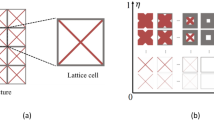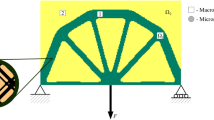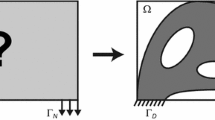Abstract
Ultralight lattice structures exhibit excellent mechanical performance and have been used widely. In structural design, the fundamental frequency is highly important. Therefore, a multiscale topology optimization method was utilized to optimize the fundamental frequency of multimaterial lattice structures in this study. Two types of optimization problems were studied, namely, maximizing the natural fundamental frequency with mass constraints and minimizing compliance with frequency constraints. The Heaviside-penalty-based discrete material optimization method was adopted for the optimal selection of candidate materials. The asymptotic homogenization method was used to evaluate the equivalent macroscale properties according to the microstructure of the lattice material. To enable gradient optimization, sensitivities were outlined in detail. A density filter with a volume-preserving Heaviside projection was used to eliminate the risk of a checkerboard pattern and reduce the number of gray elements. A polynomial penalization scheme was employed to eliminate localized spurious eigenmodes in the low-density region. Finally, several numerical examples were performed to validate the proposed method. These numerical examples resulted in novel microstructural configurations with remarkably improved vibration resistance.











Similar content being viewed by others
References
Ahmad S, Irons BM, Zienkiewicz OC (1970) Analysis of thick and thin shell structures by curved finite elements. Int J Numer Methods Eng 2:419–451
Allaire G, Aubry S, Jouve F (2001) Eigenfrequency optimization in optimal design. Comput Methods Appl Mech Eng 190:3565–3579
Ashby MF, Gibson LJ (1997) Cellular solids: structure and properties. Press Synd Univ Cambridge, Cambridge, UK
Ashby MF, Evans T, Fleck NA et al (2000) Metal foams: a design guide. Elsevier, Amsterdam
Bendsøe MP (1989) Optimal shape design as a material distribution problem. Struct Optim 1:193–202
Bendsøe MP, Kikuchi N (1988) Generating optimal topologies in structural design using a homogenization method. Comput methods Appl Mech 71:197–224
Bogomolny M (2010) Topology optimization for free vibrations using combined approximations. Int J Numer Methods Eng 82:617–636
Bruns TE, Tortorelli DA (2001) Topology optimization of non-linear elastic structures and compliant mechanisms. Comput Methods Appl Mech Eng 190:3443–3459
Bruyneel M (2011) SFP—a new parameterization based on shape functions for optimal material selection: application to conventional composite plies. Struct Multidiscip Optim 43:17–27
Cai YW, Xu L, Cheng GD (2014) Novel numerical implementation of asymptotic homogenization method for periodic plate structures. Int J Solids Struct 51:284–292
Cheng GD, Olhoff N (1981) An investigation concerning optimal-design of solid elastic plates. Int J Solids Struct 17:305–323
Cheng GD, Wang B (2007) Constraint continuity analysis approach to structural topology optimization with frequency objective/constraints. В: Proceeding of the 7th world congress of structural and multidisciplinary optimization. Seoul, Korea
Cheng GD, Cai YW, Xu L (2013) Novel implementation of homogenization method to predict effective properties of periodic materials. Acta Mech Sinica 29:550–556
Deng JD, Yan J, Cheng GD (2013) Multi-objective concurrent topology optimization of thermoelastic structures composed of homogeneous porous material. Struct Multidiscip Optim 47:583–597
Deshpande VS, Fleck NA, Ashby MF (2001) Effective properties of the octet-truss lattice material. J Mech Phys Solids 49:1747–1769
Diaz AR, Kikuchi N (1992) Solutions to shape and topology eigenvalue optimization problems using a homogenization method. Int J Numer Methods Eng 35:1487–1502
Du JB, Olhoff N (2007) Topological design of freely vibrating continuum structures for maximum values of simple and multiple eigenfrequencies and frequency gaps. Struct Multidiscip Optim 34:91–110
Duan ZY, Yan J, Zhao GZ (2015) Integrated optimization of the material and structure of composites based on the Heaviside penalization of discrete material model. Struct Multidiscip Optim 51:721–732
Felippa CA (2004) Introduction to finite element methods. Course Notes, Dep Aerosp Engineeing Sci Univ Color Boulder, available http//www.colorado.edu/engineering/Aerospace/CAS/courses.d/IFEM.d
Gao T, Zhang WH, Duysinx P (2012) A bi-value coding parameterization scheme for the discrete optimal orientation design of the composite laminate. Int J Numer Methods Eng 91:98–114
Grandhi R (1993) Structural optimization with frequency constraints - a review. AIAA J 31:2296–2303
Guest JK, Asadpoure A, Ha SH (2011) Eliminating beta-continuation from Heaviside projection and density filter algorithms. Struct Multidiscip Optim 44:443–453
Hassani B, Hinton E (1998) A review of homogenization and topology optimization I—homogenization theory for media with periodic structure. Comput Struct 69:707–717
Hayes AM, Wang AJ, Dempsey BM, McDowell DL (2004) Mechanics of linear cellular alloys. Mech Mater 36:691–713
Hutchinson RG, Fleck NA (2006) The structural performance of the periodic truss. J Mech Phys Solids 54:756–782
Jensen JS, Pedersen NL (2006) On maximal eigenfrequency separation in two-material structures: the 1D and 2D scalar cases. J Sound Vib 289:967–986
Jog CS (2002) Topology design of structures subjected to periodic loading. J Sound Vib 253:687–709
Liu ST, Cheng GD, Gu Y, Zheng XG (2002) Mapping method for sensitivity analysis of composite material property. Struct Multidiscip Optim 24:212–217
Liu L, Yan J, Cheng GD (2008) Optimum structure with homogeneous optimum truss-like material. Comput Struct 86:1417–1425
Ma ZD, Cheng HC, Kikuchi N (1994) Structural design for obtaining desired eigenfrequencies by using the topology and shape optimization method. Comput Syst Eng 5:77–89
Ma ZD, Kikuchi N, Cheng HC, Hagiwara I (1995) Topological optimization technique for free vibration problems. J Appl Mech 62:357–358
Moon SK, Tan YE, Hwang J, Yoon YJ (2014) Application of 3D printing technology for designing light-weight unmanned aerial vehicle wing structures. Int J Precis Eng Manuf Technol 1:223–228
Neves MM, Rodrigues H, Guedes JM (1995) Generalized topology design of structures with a buckling load criterion. Struct Optim 10:71–78
Niu B, Yan J, Cheng GD (2009) Optimum structure with homogeneous optimum cellular material for maximum fundamental frequency. Struct Multidiscip Optim 39:115–132
Pedersen NL (2000) Maximization of eigenvalues using topology optimization. Struct Multidiscip Optim 20:2–11
Rodrigues H, Guedes JM, Bendsoe MP (2002) Hierarchical optimization of material and structure. Struct Multidiscip Optim 24:1–10
Rozvany GIN, Zhou M, Birker T (1992) Generalized shape optimization without homogenization. Struct Optim 4:250–252
Saleeb AF, Chang TY, Graf W (1987) A quadrilateral shell element using a mixed formulation. Comput Struct 26:787–803
Schaedler TA, Jacobsen AJ, Torrents A et al (2011) Ultralight metallic microlattices. Science 334:962–965
Schury F, Stingl M, Wein F (2012) Efficient two-scale optimization of manufacturable graded structures. SIAM J Sci Comput 34:B711–B733
Sigmund O (1994) Materials with prescribed constitutive parameters—an inverse homogenization problem. Int J Solids Struct 31:2313–2329
Sivapuram R, Dunning PD, Kim HA (2016) Simultaneous material and structural optimization by multiscale topology optimization. Struct Multidiscip Optim 54:1267–1281
Soto CA, Diaz AR (1993) Layout of plate structures for improved dynamic response using a homogenization method. Asme Des Eng Div Publ De, Asme, New York, Ny,(USA) 1993(65):667–674
Stegmann J, Lund E (2005) Discrete material optimization of general composite shell structures. Int J Numer Methods Eng 62:2009–2027
Svanberg K (1987) The method of moving asymptotes—a new method for structural optimization. Int J Numer Methods Eng 24:359–373
Tcherniak D (2002) Topology optimization of resonating structures using SIMP method. Int J Numer Methods Eng 54:1605–1622
Tomasz L, Joachim TJ (2000) Plates, laminates and shells: asymptotic analysis and homogenization. World Scientific, Singapore
Vatanabe SL, Paulino GH, Silva ECN (2014) Maximizing phononic band gaps in piezocomposite materials by means of topology optimization. J Acoust Soc Am 136:494–501
Wicks N, Hutchinson JW (2001) Optimal truss plates. Int J Solids Struct 38:5165–5183
Xu L, Cheng GD (2017) Shear stiffness prediction of Reissner–Mindlin plates with periodic microstructures. Mech Adv Mater Struct 24:271–286
Xu SL, Cai YW, Cheng GD (2010) Volume preserving nonlinear density filter based on heaviside functions. Struct Multidiscip Optim 41:495–505
Yan J, Hu WB, Duan ZY (2015) Structure/material concurrent optimization of lattice materials based on extended multiscale finite element method. Int J Multiscale Comput Eng 13:73–90
Yi SN, Xu L, Cheng GD, Cai YW (2015) FEM formulation of homogenization method for effective properties of periodic heterogeneous beam and size effect of basic cell in thickness direction. Comput Struct 156:1–11
Zhang X, Yao JH, Liu B et al (2018) Three-dimensional high-entropy alloy-polymer composite nanolattices that overcome the strength-recoverability trade-off. Nano Lett 18:4247–4256
Zheng X, Lee H, Weisgraber TH et al (2014) Ultralight, ultrastiff mechanical metamaterials. Science 344:1373–1377
Zienkiewicz O, Taylor R (2005) The finite element method for solid and structural mechanics. Elsevier, Amsterdam
Funding
This research was financially supported by the National Natural Science Foundation of China (No. 11672057, 11711530018, 51975087), the National Key R&D Program of China (2017YFC0307203), Program (LR2017001) for Excellent Talents at Colleges and Universities in Liaoning Province, the 111 project (B14013), the Lightweight Optimization and High Reliability 3D Printing Technology for Aeroengine Parts, Scientific Research Program of Shanghai Science and Technology Commissio (17DZ1120000), the STINT Project of Lund University and China Scholarship Council (CSC).
Author information
Authors and Affiliations
Corresponding author
Ethics declarations
Conflict of interest
The authors declare that they have no conflict of interest.
Additional information
Responsible Editor: Michael Kokkolaras
Publisher’s note
Springer Nature remains neutral with regard to jurisdictional claims in published maps and institutional affiliations.
Rights and permissions
About this article
Cite this article
Fan, Z., Yan, J., Wallin, M. et al. Multiscale eigenfrequency optimization of multimaterial lattice structures based on the asymptotic homogenization method. Struct Multidisc Optim 61, 983–998 (2020). https://doi.org/10.1007/s00158-019-02399-0
Received:
Revised:
Accepted:
Published:
Issue Date:
DOI: https://doi.org/10.1007/s00158-019-02399-0




